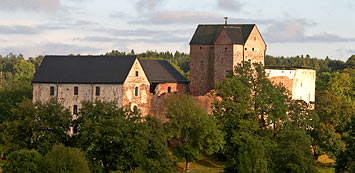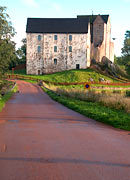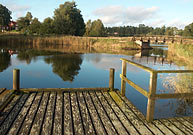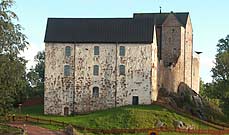History of Kastelholm Castle
The Origin of the castle of Kastelholm is lost in the darkness of centuries and not known by historical scholarship. The castle was first mentioned in 1388, when Kastelholmhus (House of Kastelholm) fell into the hands of Danish Queen Margareta, which had result carve-up of the heritage of Bo Jonsson Gripp, the chancellor, royal advisor, lender, and the richest Swedish tycoon. It is believed that the oldest part of the castle dated from the 12 AD.
The castle was built on strategically advantageous location on the little island (now it is located on the peninsula, due to uplift of the Baltic Shield), near the main road that crosses the island of Fast Åland from west to east from Eckero to Bomarzund and represents itself a kind of "Gateway to Finland."
Originally, the Kastelholm looks like the stone house, surrounded by a 3-meter-thick wall. Afterwords, the forburg was added to the north side, and the house itself was rebuilt as a tower. The castle was surrounded by a moat with dig into it a few rows of sharpened logs.
Kastelholm became an administrative center of Åland province (there were tax office, court, jail, post office, etc.) and the residence of the royal governors. Among them were such well-known names as Svante Sture, Bishop of Hemet Gadh, Eric Iohanson (father of king Gustav Vasa), Carl Knutson Bunde (the governor of Vyborg in 1490-s, died in Kastelholm in 1500).
In 1450-s the castle was rebuilt by order of the Niels Goldenshterna, Danish Stuart at the Swedish throne. The castle got a second (North) courtyard and an additional defensive wall.
At the beginning of the 16AD Kastelholm has been under several attacks and the castle in 1507 was captured, sacked and burned by the Danes. In 1523 Swedes recaptured the castle, after that it was thoroughly renovated. The Swedish king Gustav Vasa spent several months here in 1556, and appointed his son Johan (the future King Johan III) to the post of governor of Åland province.
In 1571 Kastelholm served as a prison for his brother of Johan, the deposed King Eric XIV. Klas Belke, one of the leader of the Sweden Civil War on the side of King Sigismund, was another famous prisoner of Kastelholm. Ye spent here five years from 1600.
In 1599 during that Cavil War, Kastelholm was besieged by the army of Duke Charles (Karl IX). The commandant of the castle and big supporter of King Sigismund, Lieutenant Solomon Ile surrendered the fortress after a long bombardment of large caliber guns from the ships of Admiral Jakim Shill. The castle was restored soon , but in 1619 there was a big fire and all the works have gone to dust.
In 1631, under the last governor of the island of Åland Otto Mornere, Kastelholm was thoroughly repaired again. Gustav II Adolf ordered to put the castle in order so" persons of noble blood could be placed here if it will be need". However, in 1634 Åland province was administratively reassign to the Governor in Abo and Kastelholm as a fortress and an administrative center has lost it's value and began to decline.
Some time it was used as a prison, but then after a fire in 1745 Kastelholm castle was almost entirely abandoned. There was only mail post till 1809. The surviving North wing was used as a granary up to 1931, and the charred ruins were gradually dismantled for building materials for the construction of a nearby county jail building.
Restoration of the castle started in 1982 and archaeological investigations of the castle and the surrounding area also. The works successfully ended in 1989 and after that Kastelholm castle was opened for visitors.
That's the story ...
Impressions
It was very nice. Especially in the evening, at sunset, in combination with the surrounding nature and the Aland roads all in red.
Compact, tough, functional Castle of the North. There are pretty much various premises, rooms and passages on relatively small area. There are no authentic interiors survived, alas. Tracks of restoration plainly visible - new made metal ladders, railings and roof. But you have your fantasy and Kastelholm's history background. What else you need?
There is a some entrance fee in the castle, also you can visit prison museum Vita Björn, as well as get acquaintance with the life of the Aland's village of 19AD.
Land forts and fortress:
Bip Castle Gatchina Ivangorod Izborsk Kexholm Kirillov Monastery Koporye Novgorod Pechorskiy Monastery Peter&Paul Fortress Porkhov Pskov Schlisselburg Staraya Ladoga Tikhvin Vyborg Hameenlinna Hamina Kastelholm Kymenlinna Lappaenranta Raseborg Castle Savonlinna Tavetti Turku Visby Fredrikstadt Fredriksten Hegra Fort Hoytorp Fort Arensburg Narva Tallinn Antipatris Caesarea Jerusalem Latrun Fort Masada
Sea forts and fortresses:
Alexander Fort Ino Fort Krasnaya Gorka Fort Kronstadt: Kotlin isl. Kronstadt: North Forts Kronstadt: South Forts Trongsund Hanko Svartholm Sveaborg Marstrand Siaro Fort Vaxholm Oscarsborg
Artillery batteries and individual guns:
Coastal Artillery Hemso Fort
Fortified areas and defensive lines:
Karelian Fortified Area (KaUR) KrUR Leningrad Mannerheim Line Nevsky Bridgehead VT Line Harparskog Line Salpa Line Gothland
Russian
S e a r c h All news

 Kastelholm Castle
Kastelholm Castle
 Walls of Kastelholm Castle
Walls of Kastelholm Castle
 Kastelholm Castle Museum
Kastelholm Castle Museum
 fjord Ledangsviken
fjord Ledangsviken

